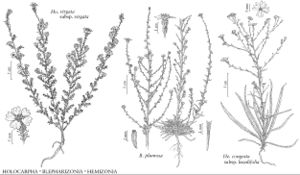Holocarpha
Fl. Francisc., 426. 1897.
| Taxon | Illustrator ⠉ | |
|---|---|---|
 | Holocarpha virgata Blepharizonia plumosa Hemizonia congesta subsp. luzulifolia | Marjorie C. Leggitt Marjorie C. Leggitt Marjorie C. Leggitt |
Annuals, 10–120 cm. Stems ± erect. Leaves mostly cauline (at flowering); proximal opposite (forming winter–spring rosettes, usually withering before flowering), mostly alternate; sessile; blades linear to oblanceolate, margins serrate to serrulate or entire, faces hirsute to strigose, sericeous, or villous (distal leaves sometimes stipitate-glandular and/or glanddotted as well, apices of distal leaves usually each with pit-gland). Heads radiate, borne singly or in± corymbiform, paniculiform, racemiform, or spiciform arrays or in glomerules. Peduncular bracts: pit-glands 1 (terminal). Involucres ± obconic or campanulate to ± globose, 4–8+ mm diam. Phyllaries 3–16 in 1 series (elliptic, oblanceolate, or obovate, herbaceous, each usually 1/2 enveloping a subtended ray-floret proximally, abaxially with pit-gland-tipped processes and glabrous or hispid, hispidulous, puberulent, and/or sessile or stipitate-glandular). Receptacles flat to convex, glabrous, paleate (paleae subtending all or most disc-florets). Ray-florets 3–16, pistillate, fertile; corollas yellow (without purplish nerves, lobes 1/8–1/2 lengths of laminae, ± parallel). Disc-florets 9–90, some bisexual and fertile, the rest functionally staminate; corollas yellow, tubes shorter than or about equaling funnelform throats, lobes 5, deltate (anthers yellow to brownish or reddish to dark purple; styles glabrous proximal to branches). Ray cypselae ± obcompressed (gibbous, basal attachments lateral, apices beaked, beaks adaxial, ascending, faces glabrous); pappi 0. Disc cypselae ± clavate (basal attachments central, apices beakless, faces glabrous); pappi 0. x = 6.
Discussion
Species 4 (4 in the flora).
Molecular phylogenetic data have indicated that Holocarpha is most closely related to Deinandra (S. Carlquist et al. 2003). The low chromosome numbers in Holocarpha are probably the result of extensive, descending dysploidy. All are self-incompatible.
Selected References
Key
| 1 | Anthers yellow to brownish | > 2 |
| 1 | Anthers reddish to dark purple | > 3 |
| 2 | Stems resinous distally (not notably stipitate-glandular); involucres ± obconic to ± globose; phyllaries each bearing (0–)5–15(–20) gland-tipped processes and usually glabrous orminutely sessile- or stipitate-glandular, rarely hispid | Holocarpha obconica |
| 2 | Stems notably stipitate-glandular; involucres campanulate to ± globose; phyllaries each bearing 25–50 gland-tipped processes and minutely sessile- or stipitate-glandular and puberulent or hispidulous | Holocarpha heermannii |
| 3 | Heads borne singly or in glomerules or spiciform-glomerulate arrays; ray florets 8–16; disc florets 40–90 | Holocarpha macradenia |
| 3 | Heads in ± racemiform to spiciform arrays; ray florets 3–7; disc florets 9–25 | Holocarpha virgata |